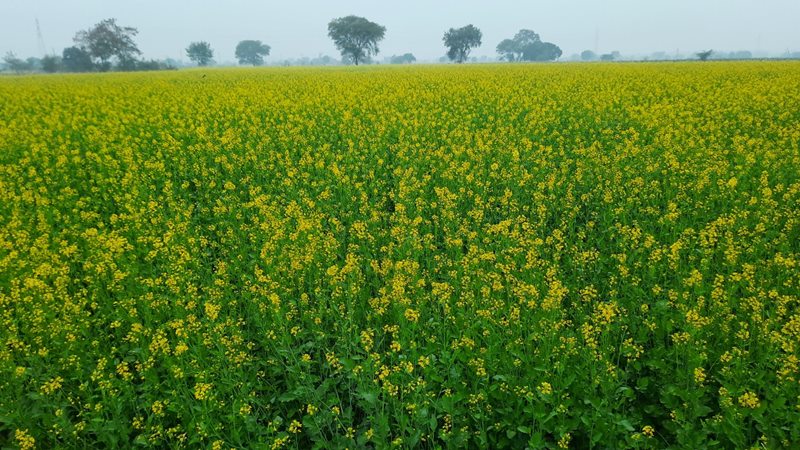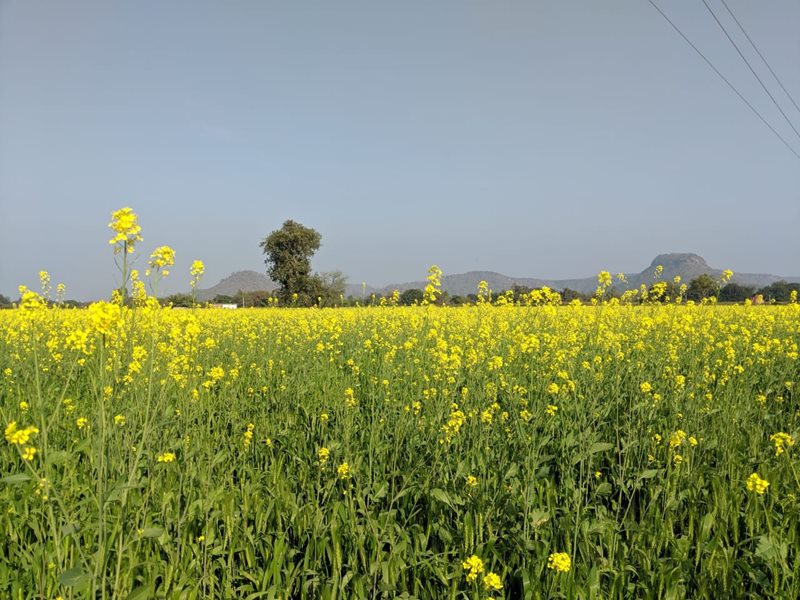Growing more mustard can make India self sufficient in edible oils
Mustard cultivation is low maintenance and farmer-friendly as it requires less seeds, less water and less fertilisers to grow, and yet brings a good price. It also facilitates supplementary sources of income as beekeeping in the mustard fields works very well.


Many farmers have cultivated mustard as it is fetching a good price in the market. Photo: Divendra Singh
The country is yet to become self sufficient in oilseed production. Every year India has to import edible oil to meet the demand of the population. And one of the major imports is palm oil.
There is a way forward to increase the cultivation and production of oilseeds in the country and save millions for the exchequer.
There are yellow fields of mustard as far as the eye can see in Rajasthan, Madhya Pradesh, Uttar Pradesh and Haryana among other states in the country. This abundance of mustard cultivation is because farmers in these areas have chosen to cultivate more mustard than any other crop in the rabi season.
Many farmers have cultivated mustard as it is fetching a good price in the market. Last year, mustard sold at almost double the rate of what the government had fixed for it. In 2020-21, the Minimum Support Price (MSP) for a quintal of mustard was Rs 4650. But the farmers got nearly double that in the markets. Even currently, mustard, mustard oil and mustard cakes that are used as fertilisers, are going for a good price.
One of the reasons for this was increased awareness about locally grown foodstuff including oils, especially during the pandemic.
For the rabi crop of year 2022-23, the government has fixed the MSP of mustard at Rs 5,050 a quintal, an increase of Rs 400 a quintal from the previous year.

The expenditure of cultivating a quintal of mustard is Rs 2,523. So, even if the farmers choose to sell at the government MSP, they still stand to make a profit of Rs 2,527.
The mustard fields in Rajasthan, Madhya Pradesh, Uttar Pradesh and Haryana are flowering right now. The crops are healthy and pest-free. Farmers and traders of mustard are confident that they will make a profit on it.
Groundnuts, soybean, mustard, sunflower, sesame, niger seeds, rapeseed, safflower and linseed are some of the major oilseeds that are cultivated in India. The most cultivated edible oilseeds in the country are groundnut, soyabean and mustard.
Mustard is cultivated extensively in north India. Rajasthan leads in mustard cultivation with 46.06 per cent, followed by Haryana with 12.60 per cent, Madhya Pradesh with 11.38 per cent, Uttar Pradesh with 10.49 per cent and West Bengal with 7.81 per cent.
Also Read: Indian Oilseeds Sacrificed For Cheap Imported Oils

In Madhya Pradesh the acreage of mustard cultivation in the rabi cultivation of 2021-22, has gone up by nearly 25 per cent. But the yield in Madhya Pradesh per hectare is less than Rajasthan and Haryana. There is a need to increase the yield of oilseeds too in Madhya Pradesh and in other low-yielding states of the country. Scientific intervention and government schemes can go a long way in doing that.
With this kind of help, Madhya Pradesh can emerge as a leading mustard producer in the country.
The government has all along encouraged the cultivation of mustard in the country. The Krishi Vigyan Kendras across the country have held demos, training sessions and awareness drives on mustard cultivation for farmers, and shared technological know how to improve the yield. Several institutions such as the Indian Council of Agriculture Research (ICAR), Delhi, Directorate of Rapeseed-Mustard Research (ICAR) Bharatpur, Rajasthan and many agricultural universities are working constantly to increase the yield and quality of edible oilseeds.
Compared to other crops, mustard cultivation is less expensive. Mustard farming requires less seeds, less fertilisers and less irrigation. Preparing the land to grow the mustard crop is also relatively easier for the farmers. Those areas where groundwater is scarce and cultivation is rainwater-dependent, a rabi crop of mustard is a very viable option for farmers.

The cultivation of mustard also supports bee keeping. The bees pollinate and can increase the yield of the mustard up to 20 per cent. Bee-keeping is also an additional source of income for the farmers through honey and bee-wax.
Also Read: Beekeeping gives the Santhal tribal women in Banka, Bihar, a sweet taste of success
Mustard oil is widely consumed in north India and the residue after oil has been extracted from the mustard seeds is a nutritious feed for milch cattle.
Mustard cultivation therefore is a profitable venture. The low maintenance mustard crop can to a large extent fulfil the journey of the country in becoming self-sufficient in edible oils.
(Satyendra Pal Singh is chief scientist and director, Krishi Vigyan Kendra Shivpuri, Madhya Pradesh. These are his personal views)
Read the story in Hindi.

